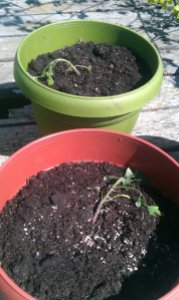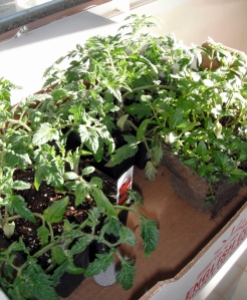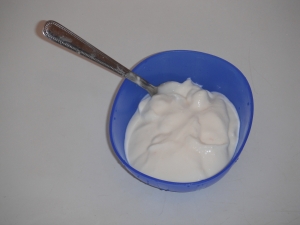
by Tessa | Homemaking
I didn’t post about my first attempt because it didn’t last long enough to be significant. I bought 6 tomato starters, transplanted them, and then thought that 15 degrees at 11:00pm meant that it would not freeze that night. I was wrong.

Poor Tomatoes
I did things a little bit differently the second time around and I’m hoping and praying for better results. I actually said a prayer over my tomatoes.
Since I killed my first 6 tomato plants in less than 24 hours of purchasing them, I have learned a lot about tomatoes. Some sites I read say that they are easy to grow. Most say they are not. They can either be “hugely satisfying or a flat out disaster.” Here are some of the tips that I learned:
I also got a couple of (free) ebooks off Amazon. I don’t have a Kindle but I put the Kindle app on my phone and computer. I have two ebooks specifically about container tomatoes and several more about gardening and container gardening in general. With all the reading I have done, I’m hoping for a bumper crop of tomatoes in the fall.

Tomato Babies

Uh oh!
So yesterday I transplanted my tomatoes, with eggshells at the bottom of the hole, and put them in a sunny spot on my deck. I made sure to bury them up to the top leaves and watered them well. I was feeling pretty good about myself and held high hopes for the future of my baby tomatoes. Until the wind started. We had just over an hour of extremely fierce wind mixed with a touch of rain. So I dragged all of my containers in the house. Just as I put the last one inside and shut the front door, my tomato babies were viciously attacked by a baby bear! My littlest munchkin thought it was great fun to have dirt in the house and decided that containers with soil are just as much fun as the sandbox. Then he got upset when I reprimanded him and took it out on my plants. Half a leaf was torn off. That plant had an extra prayer said over it. Worst case scenario, it dies. I have a few back ups just in case.
Today is looking sunny already, albeit a little bit windy. My littlest allowed me to sneak away this morning and slept just long enough for me to move my containers back outside and water them well. He will realize they are out of his reach and my little spitfire will certainly let me know his feelings on the matter but, for now, both the tomatoes and my little guy are content. Now to see if I can keep them alive. The tomatoes I mean. I’m pretty good at keeping my kids alive for longer than a day! Please tell me that I’m not the only one who has had such terrible luck with tomatoes. And if you have good luck, what’s your trick?
The irony of it all: I don’t even like tomatoes. I only want them to make homemade spaghetti sauce.

by Tessa | Homemaking

I have been making yogurt (on and off) since September 2011. I have read a whole bunch of recipes and, through much trial and error, found a recipe that works for my family. Some things that I have learned about how to make yogurt are as follows:
1. The longer you let the yogurt ferment, the more tart it becomes. My family does not like tart yogurt so about 4-5 hours results in a milder taste.
2. If the milk boils over you can clean up the mess while it cools down and the remaining milk will still work for yogurt.
3. A thermometer is handy to have but not essential.
4. White/clear vanilla tastes much better than the dark stuff.
I will tell you my method but you may need to tweak it a bit for your family’s taste preference.
Materials required:
- Container(s) for finished yogurt with a secure lid (glass or plastic works)
- Enough milk to fill your container(s)
- Pot with a lid that will fit the milk
- Thermometer (handy but optional)
- Yogurt starter or some store-bought yogurt with live, active bacterial cultures (doesn’t really matter which brand, I have had success with several kinds, it is handy if it is plain or vanilla because otherwise you end up with a couple chunks of fruit in your yogurt)
- For greek yogurt: fabric to strain through (I have used cotton flat diapers and flannel receiving blankets), colander, and a pot that fits the colander if you want to save the whey
Steps:
- Put milk into pot.
- Heat the milk until almost boiling (about 180F). It will reach this temperature much faster if you use a lid.
- Simmer at this temperature for about 1-2 hours (with a lid so it doesn’t lose heat)
- Remove from heat. At this point you can put it into a sink full of cold water to speed cooling or just let it sit on your counter to cool. It is ready when it is about the same temp as a warm (not hot) bath (about 110F). If it is too hot your starter bacteria will die. (I tried to think of another way to word that but “get killed” sounded just as drastic)
- Have about a tablespoon of starter yogurt per liter of milk. Put them in a separate small bowl and add a few tablespoons of milk. Mix well. It is easier to mix into a large milk amount when it is diluted a bit with the milk already.
- Pour milk-diluted starter into your milk and mix well. At this point you can also add some vanilla or other extract. (Some recipes say you can add sugar/sweetener at this point but I have never had luck with that.)
- Pour into your yogurt container(s).
- Wrap in a blanket and/or put in a warm place where it will not get disturbed while it ferments. I usually turn my oven on for a bit (until it reaches about 100F) and then turn it off, wrap my yogurt in a blanket and put it in the oven. I have also put it in the bathtub wrapped in a blanket but that piqued my sons’ curiosity a little too much. In the oven it is out of their sight.
- Let it sit, undisturbed, for about 4-5 hours.
- Put it in the fridge overnight and by morning you will have yogurt!
Greek yogurt:
- The next morning pour/dump your yogurt into the colander lined with the fabric
- Put it in the fridge and let the whey drip out. I usually leave it for about 3 hours for 7 cups of yogurt.
- Put it back in the container (or in a different one if you prefer).
Note: For 7 cups of yogurt I end up with about 2 -3 cups of Greek yogurt. And you can use the whey for numerous things, though I still haven’t figured out what to use mine for.
So there you have it. Here is the short version: Heat milk, cool milk, add starter, let it sit in warmth, overnight it in the fridge and enjoy!
I usually start my yogurt at about 2pm (while my littlest is napping) and heat till around 4. Then it ferments until about 9 and I stick it in the fridge overnight. I set my oven timer and have even put reminders on my phone because otherwise I forget about it.
Have you ever made yogurt? I’d love to hear your yogurt making stories!
Do you have any other tips/tricks to share?












